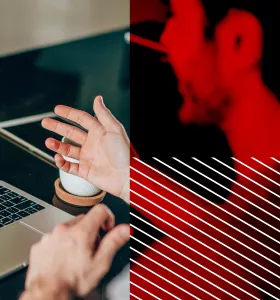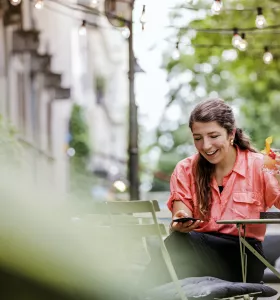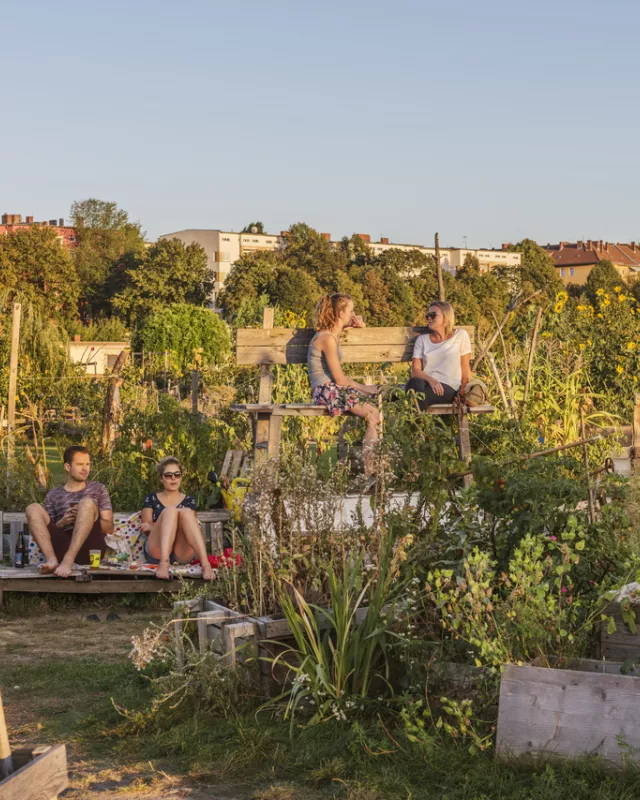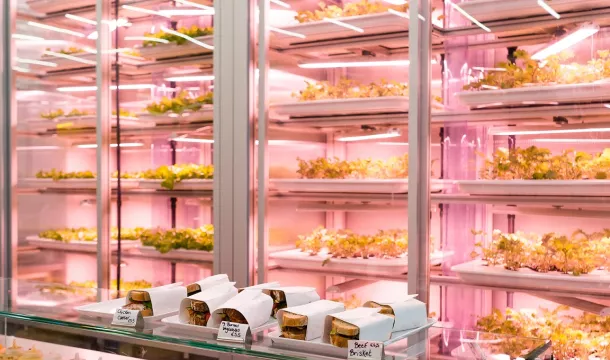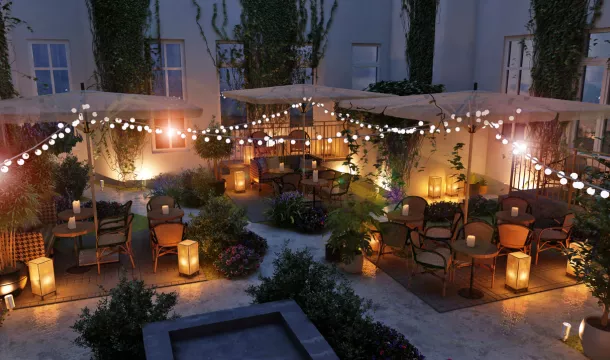Explore the capital of green trends
How Berlin leads the way in urban sustainability
Berliners love to ‘go green’. Urban farming, green fashion and vegan gastronomy are turning the former industrial city of Berlin into an ever-increasing green metropolis. Change is driven by a desire to preserve and expand green oases, coupled with the willingness to follow sustainable and alternative paths.
The city has long been known for its urban nature: more than a third of the city is green space, half of which is forest. Public parks are like extended living rooms, every threatened tree is protected and those who don't have their own allotment garden can join one of numerous community garden projects, feed off aquaponic farms or become self-sufficient permaculture gardeners. Beyond its residents' traditional closeness to nature, Berlin is also a city for sustainable trends. For many locals, the (carefully chosen) bicycle has replaced the car as a status symbol. In DIY and upcycling workshops, Berliners learn how to make their own furniture and clothing instead of surrendering to industrial mass production. Zero waste living, plastic-free shops or rescued food has become all the rage.
Trend conscious Berliners live up to LOHAS ("lifestyle of health and sustainability"): enjoying the pleasures of life whilst eating a healthy diet and making sustainable choices in their consumption. For example, clothes should be made in an ethical way, but should also be fashionable. The desire to preserve and expand green oases, coupled with the willingness to follow sustainable and alternative paths, makes Berlin a green metropolis on all levels.
Why Berlin Emerges As A Hub For Conscious Living
Berlin has always been home to people with alternative visions and utopian ideas - a feature that has been attracting creative folks from around the world for years. It is this unique mix of influences from the world’s most progressive cultures flowing together that shapes Berlin’s identity as a hub for new green lifestyles.
Ironically, the fact that Berlin has been “poor, but sexy” for many decades is benefitting this trend. Locals are less driven by materialistic life goals and instead focus on making the best use of the resources that are already available.
The German capital is also ‘green’ in the truest sense: Over 300 km2 of the city is green space, filled with more than 430,000 trees. This abundance of nature can be ascribed to the city's history as a royal capital, where parks such as the Tiergarten and gardens at Charlottenburg Palace were built by the Prussian kings. In the 19th century, amidst the tenements and factories of a newly industrial city, allotments arose as oases of green - many still exist today. As Berlin expanded to its present borders in 1920, several towns and dozens of villages were incorporated into the city, together with the green spaces in-between. During the era of division, these recreation areas became necessary for survival: without them, the walled-in West Berliners probably could not have subsisted the division. Since the fall of the Wall, parts of the former no-man's strip have been turned into new bike paths, parks or gardens. An overview of Berlin’s parks and gardens can be found at www.visitBerlin.de/en/see/sightseeing/green-berlin.
At the same time, the city’s young history of division played a significant role in forming its unconventional mindset: as the Wall ran through the city, various subcultures emerged near its borders in Prenzlauer Berg or Kreuzberg. After the Fall of the Wall more than 30 years ago they emerged from their hideouts and were suddenly shaping the city’s central areas. Also, the post-GDR era with its numerous empty houses and factories gave room for utopian projects to seed and grow.
Berlin is never standing still. It went through countless transformations in a relatively short period of time which strongly impacted the people: they are curious and open to new ideas, making Berlin the perfect place for new, sustainable trends to evolve. Today, the city feeds from this “make-it-happen” mentality. Its green culture is largely driven by bottom-up initiatives, self-sustaining communities and social enterprises, adding to the feeling that anything is possible. And even those who visit Berlin only for a few days can leave a positive impact.
Eco Exploring: Sustainable Urban Tours
For those who want to experience Berlin’s eco-fair fashion scene, the Green Fashion Tours organize unique guided tours, taking guests to meet the designers and store managers behind the most interesting projects in town. The world of green design can also be discovered with GoArt, an agency specialising in the latest creative trends in the capital. greenfashiontours.com , goart-berlin.de
When it comes to phenomena such as community gardening, co-housing and alternative culture, the creative sustainability tours by id22 offer insights to Berlin’s self-organized initiatives and urban regeneration experiments. Those wanting to focus on architecture and urban design can also explore Berlin’s open spaces with Ticket B’s Green City Bike Tour. creative-sustainability-tours-berlin.net , ticket-b.de
Numerous tour companies also help visitors to see Berlin on two wheels. If cycling is not already green enough, Berlin on Bike’s “Future Berlin” tour takes a look at the Berlin’s transformation into a sustainable metropolis, while their “Green Oasis” tour offers an insider’s view of the city’s creative green spaces. berlinonbike.de/en
Even Berlin’s growing circular economy movement now has its own guided tour: the Circular Economy Tours take groups to innovative circular projects and startups in various neighborhoods. circulareconomytours.com
Rethinking Urban Mobility
No Need To Own A Car in Berlin
About 50% of all Berlin households manage to get by without owning a car and instead use the exemplary public transport system to get themselves around the entire city day or night. The Berlin public transport company is now doing something to make its lines even more sustainable: Some buses are already equipped with hydrogen-power internal combustion engines and the first electro busses run through the city. The trams run on specially built lawn tracks that reduce air and noise pollution. Visitors are also out and about using the city's environmentally friendly U-Bahn, S-Bahn, trams and buses: anyone spending a few days in Berlin can take advantage of the practical and affordable ticket from visitBerlin, the Berlin WelcomeCard: this allows free and flexible use of public transport and also offers discounts from about 200 tourist highlights of the city. berlin-welcomecard.de/en
Also very popular with residents is car sharing, where an app lets you find an auto nearby which you can rent within minutes. The environmental benefit: the car is only being used if it is really needed.
Berlin Shifts To E-Mobility
The capital region is also an important site for electromobility development. Since April 2012, Berlin-Brandenburg has been participating in Showcase Electromobility, a project funded by the federal government in four cities across Germany. In the pilot project, electric vehicles will be tested for everyday life and the infrastructure improved. They offers 40 electric cars in Berlin. And since 2015, an ecological Formula E race with electric cars takes place on Berlin’s former Tempelhof Airport. emo-berlin.de
Electric scooter sharing is fully embraced by Berliners, giving them the flexibility to smoothly ride from Kiez to Kiez while hardly making any sound and reducing their carbon footprint.
Getting Around On Two Wheels
Even more environmentally friendly is Berlin's favourite: the bicycle. More than twelve per cent of all journeys in Berlin are made on two wheels, thanks to a more than 1,000 km long network of bicycle paths in the city. A chic bike is for many Berliners a far more important status symbol than a car, which they forego. Whether fixie, retro road bike, Holland or cargo bike: more and more shops have special offers for individual requests. An overview of the latest lifestyle, fashion and technology trends about bikes are offered each spring at the Berlin Bike Show and Velo Berlin. berlinerfahrradschau.de/en , veloberlin.com
Anyone in Berlin who wants to assemble their own bike should head over to concept stores Ozon Cyclery and Standert Bicycles. Ozon Cyclery assembles individual bamboo frames in workshops, and Standert designs, builds and sells custom made-in-Berlin bicycles in its showroom with attached café. ozoncyclery.com , standert.de
Visitors to Berlin are also increasingly embracing this eco-friendly means of getting around. Many companies have added bicycle discovery tours to their programmes. Berlin on Bike, Fat Tire Bikes and Fahrradstation offer guided tours on subjects such as architecture and urban history that can be booked via the Berlin Tourist Info offices. Those wishing to explore the city on their own can also rent bikes for one or more days from most of these providers. Two rather unique places to rent a bike Rent A Bike 44 and Bike Surf Berlin. Right near Tempelhofer Feld, Bike44 restores old bikes and rents them for fair prices with the aim to stay cheaper than public transport and making cycling affordable for everyone. Bike Surf is a non-profit bike sharing platform, where users can borrow bikes for by donating either money or skills and time. For easy navigation, visitBerlin has more than 50 tours with integrated maps available. berlinonbike.de/en , fahrradstation.com , fattiretours.com/berlinfacebook.com/RentABike44 , bikesurf.org , visitberlin.de/en/berlin-bike-0
If you want to be environmentally conscious without having to do the pedalling yourself, you can opt for the pedicab Velotaxi: the modern City Cruisers are equipped with a cabin made from 100 per cent recyclable polyethylene, in which two passengers can be driven comfortably across Berlin solely by the driver's muscular strength. Berlin Rikscha Tours relies on traditional Asian rickshaws and even offers wedding rides in a white decorated vehicle at. velotaxi.de , berlin-rikscha-tours.de
Eco-friendly On The Water
The Solarpolis tour, too, takes you on a solar-powered boat through the government district and through the Landwehrkanal. Passengers learn a lot about the everyday use of solar energy in Berlin. You can also rent and sail your own solar boat at SolarWaterworld, even without a licence. The headquarters in Köpenick is the perfect starting point for exploring the waterways in the southeast of the city such as the Dahme or the Müggelsee in a quiet and emission-free manner. Cruisers for up to twelve people and even a solar house boat are available. reederei-riedel.de , solarpolis.de , solarwaterworld.de/en
Even closer to the water, you can take a tour with Der Kanutourist and backstagetourism. Both operators offer guided tours through Berlin. From the kayak, sights such as Charlottenburg Palace and the Molecule Man can be seen from a whole new perspective. For those who want to take in the Spree panorama from a slightly higher position, Stand up Club Berlin rents out Stand Up Paddle boards (SUP’s) next to Berlin’s iconic Badeschiff. They also organize activities and tours, including SUP Yoga or Friday After-Work paddles. derkanutourist.de , backstagetourism.com , standupclub.de
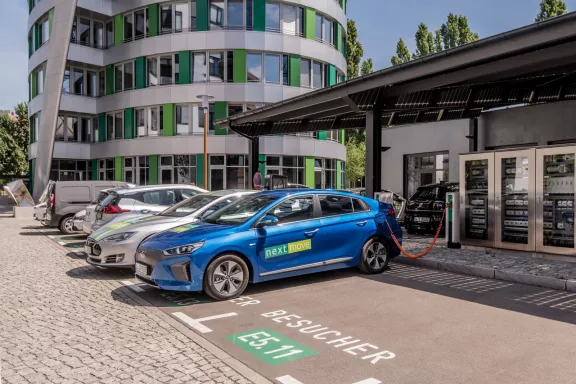
Berlin goes electric
The capital region is also an important development location for electromobility. Since April 2012, Berlin-Brandenburg has been one of four "electromobility showcases" funded by the German government. In this pilot project, electric vehicles are being tested in everyday use and the infrastructure is being improved. Miles also includes electric vehicles in its Berlin fleet. And since 2015, the Formula E race has been hosting an eco-friendly car race: electric cars compete on the former Tempelhof Airport. emo-berlin.de
Electric scooter sharing is also very popular with Berliners, as it allows them to travel flexibly – and virtually silently – from neighbourhood to neighbourhood while reducing their carbon footprint. They are easy to operate via an app and are available within the Ringbahn zone.
Environmentally friendly by water
The Riedel shipping company counts the SunCat, Berlin's first solar-powered passenger ship, among its fleet. Solarpolis also offers round trips in solar boats through the government district and across the Landwehr Canal. Passengers learn a lot about the use of solar energy in everyday life in Berlin. You can also rent Solar Water World's solar boats and drive them yourself – even without a licence. The headquarters in Köpenick is the perfect starting point for exploring the south-eastern waterways such as Dahme or Müggelsee quietly and emission-free. Cruisers and even a solar houseboat are available for up to twelve people. reederei-riedel.de , solarpolis.de , solarwaterworld.de
You can get even closer to the water with tours from Der Kanutourist and backstagetourism. These rental companies offer guided canoe tours through Berlin. From a kayak, sights such as Charlottenburg Palace and the Molecule Man take on a whole new perspective. If you want to enjoy the Spree panorama from a slightly higher position, you can rent a SUP (stand-up paddle board) from Stand up Club Berlin next to the famous Berlin Badeschiff. Special activities and tours are also organised here, including SUP yoga and "after work" excursions. derkanutourist.de , backstagetourism.com , standupclub.de
